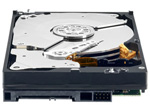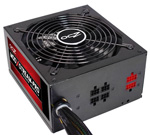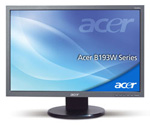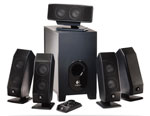Value Midrange Common Components
AMD and Intel architectures differ in sockets and sometimes memory configurations, but there is more in common than not between the two systems. For that reason the Intel and AMD value midrange systems share a number of components.
 |
The video card choice is an upgrade from the last midrange guide. The choice three months ago was the ATI 4850 512MB, but today we can recommend the ATI 4870 1GB for about the same price. The HIS H487FN1GP 1GB is just $130 after a $20 rebate. That excellent value made this card the video choice for both the Intel and AMD systems. Even without the rebate you can now find a 1GB 4870 for around $150. Our recent graphics card buyers' guide recommended the 4850 512MB as the best value in the $130 to $150 price range. Now you can spend the same $130 to $150 and get a more powerful 4870 with double the video memory. You will certainly be happy with the gaming capabilities of the 4870; it is an excellent match to the true HD video resolution of the 23" monitor chosen for the value midrange systems.
On the Intel system, the GIGABYTE GA-EP45-UD3P motherboard provides a second PCI x16 slot. Video performance can be improved even further by adding a second Radeon HD 4870 1GB in CrossFire mode. You can also upgrade to the 4890 1GB for more power at higher resolutions with "eye candy" turned on. The 4890 1GB upgrade adds about $50. The motherboard choice for AMD is the GIGABYTE GA-MA790X-UD4P, which also provides multiple x16 slots for CrossFire, although the two slots each run at x8 when both are populated. The same video options apply to the AMD value midrange system.
 |
1TB hard drives are now a routine hard drive capacity. The 1TB drives are large, fast, and stable, so it was easy to recommend the Western Digital Caviar Black 1TB drive (1000GB) at $95. There are cheaper 1TB drives available and there are many brands available with 1TB capacity. However, the Caviar Black has earned an enviable reputation for stability and performance. While there are differences between hard drives, outside of running benchmarks most people aren't likely to notice the difference in performance between Western Digital, Seagate, Samsung, Hitachi, and other major brands. All are worthy of consideration if the price per gigabyte (or terabyte) is right.
 |
Since many readers complained that Blu-Ray playback was an unnecessary expense in a value midrange system, we downgraded the optical drive to a fast DVD burner. Fortunately, DVD burners have just seen the introduction of faster burning speeds and the Sony Optiarc 24X has emerged as a favorite in recent system builds. This Sony DVD burner is the choice for both best value midrange systems. It can burn DVDs as fast as 24x speed and it supports both single and double layer media. If you like the ability to read 25GB/50GB Blu-Ray disks you can upgrade to the LG CH08LS10 Blu-Ray/DVD combo drive used in the performance midrange systems. Adding that capability increases the cost about $100.
Cases are often very personal choices when it comes to features, and you may already have a favorite. If you don't you should definitely look at the recommended Antec Three Hundred. The Three Hundred is a bottom-mount power supply design. Some love this configuration, others hate it, but it works well in the Three Hundred. It is definitely reasonable at the current $60 cost, but that does not mean it is a "cheap" case. It comes standard with a 120mm rear exhaust fan and a 140mm top fan, which both feature a 3-speed switch. There is also room to mount two additional front 120mm fans behind a washable dust filter, so you can effectively cool anything from a single hard drive to a large RAID array. Inside there are nine drive bays - six internal 3.5" and three external 5.25" drive bays. Front USB, headphone, and microphone jacks are also standard and they are conveniently located at the top of the front panel. That makes them usable in the common "on the floor" setup.
If you prefer a more traditional case configuration the Cooler Master Mystique, selling for $80, mounts the PS on top, provides font panel jacks, and is loaded with expansion ports and two 120mm fans.
 |
The Editors' Choice BFG Tech LS-550 power supply has been discontinued. The new power supply choice for the value midrange systems is the excellent OCZ ModXStream Pro 600W. The ModXStream is 80 Plus certified and a modular design. That means you use only the cables you need for your system, which makes cable management a much easier task. This OCZ is also a great value right now at $60 after a $20 rebate. The PSU is also SLI certified and CrossFire Ready.
 |
The last major component to discuss is the display, and here the tilt was toward best value at full 1080p HD (1920x1080) resolution. Six months ago we chose a "new class" of 16:9 21.5" LCD monitors that provided true 1080p resolution at the then break-through price of just $199. Now we can choose a larger Acer 23" (nominal 24") monitor for even less at $180. It is also worth mentioning that the Acer 23" is one of the few monitors in its class that comes with all three video cables. Yes, an HDMI cable is included in the Acer box. Some buyers want the cheapest monitor they can find. The ASUS 21.5" chosen in earlier Buyers' Guides is now $149 after a $10 rebate. The resolution is the same as the Acer 23". Choosing the ASUS 21.5" instead saves you about $30 for those on a tight budget, with a reduction in pixel pitch from 0.271mm to 0.248mm.
 |
The Logitech X-540 has been a favorite of users looking for a reasonably priced but good performing, powered 5.1 computer speaker system. At $79 it will certainly not challenge the performance of a separate Dolby amplifier powering audiophile speakers, but it will provide surprisingly good sound for the price. The Creative Inspire T6100 76W 5.1 speaker system is a similar powered speaker system that is selling at about the same price as the X-540. Either speaker system is a good choice for these value midrange builds.
These are clearly desktop systems, so the keyboard and optical mouse are the basic Microsoft OEM kit. If you have specific needs or a favorite gaming mouse, you likely know exactly what you prefer. The Microsoft pair is very capable for most. For greatest compatibility we have chosen Microsoft Vista Home Premium OEM as the operating system. Unless you have specific networking and special enterprise security needs there is no real reason to pay the extra for Vista Ultimate.










71 Comments
View All Comments
Black Jacque - Monday, July 27, 2009 - link
>For instance there are hardly any quality power supplies in the 450->550W range that offer 2 6-pin PCIe connectors (a requirement to run >HD 4870/90 and GTX 260/275 cards).Like the Seasonic S12II-430 Bronze (1xPCIe-6, 1xPCIe-6+2)?
In addition, most GPUs come with a Power Cable to adapt the standard Molex to PCIe-6. The recommended MSI HD 4890 comes with two Power Cables.
> it makes good long term sense to throw in another $25 and get a >more powerful PS for your future upgrade needs.
The Xbit Labs article clearly states the trend in PC parts power consumption is downward, not upward. Besides, I'd rather not spend US$25 that I didn't have to. I could use that money to upgrade to a Q9400 or an E8500, something I could use rightaway.
Nfarce - Monday, July 27, 2009 - link
"Like the Seasonic S12II-430 Bronze (1xPCIe-6, 1xPCIe-6+2)? "Not real familiar with that brand. Try finding one in the range I mentioned built by Antec, Corsair, OCZ, Thermaltake, or PC Power & Cooling. And 430W? I have that in a five year old P4 system. I don't think so. I'll spend the extra few clams on something future proof, and apparently others agree. If you have to worry about spending another $25 on an $850+ PC build, then maybe you need to reconsider your spending priorities.
Black Jacque - Monday, July 27, 2009 - link
>Not real familiar with that brand. Try finding one in the range I >mentioned built by Antec, Corsair, OCZ, Thermaltake, or PC Power & >Cooling.Seasonic can be found providing OEM service on various model lines for: Antec, Corsair, PC Power and Cooling, and of course under their own Seasonic brand. Actually, the PSUs that Seasonic either designs or builds for Antec, Corsair or the old PCP&P are not as high quality as the PSUs they build under their own brand label.
Nfarce - Tuesday, July 28, 2009 - link
Thanks for the info Black Jacque. I did not know that, and I now verified that fact. Of all the PS research I did prior to my build, no reviews mentioned that fact. However, I will still stand by spending a little more on a future proof power supply so as one less thing to have to upgrade. My Corsair 750W will take me into next year's planned Lynnfield build and the new DX11 cards with SLI (hopefully).haplo602 - Monday, July 27, 2009 - link
the article is one from the "how much power do we need" round that almost every major hardware review site did.however it was more or less questioning the need of 700+ W PSUs for the normal systems (i.e. average home PC).
you have to account also for the usage pattern. this site is aimed at the hardware enthusiasts. they tend to buy informed or tend to change components often. in the first case, they will ignore the PSU recommendation, in the 2nd case, it comes in handy in the future.
also have a look at power consumption on overclocked components (f.e. CPUs increase quite dramaticaly with added voltage). IIRC the xbitlabs article did not take into account overclocking (I might be wrong, did not read into details there).
brybir - Monday, July 27, 2009 - link
You keep referring to that article and after raeding it I do find it interesting. But all it says is that usage is trending downword. That trend is based on events that have already happened and then assuming what future events will occur with power draw based off similar past events.First, just because the trend is in one direction does not mean that it is going to continue that way in the future. That is to say that the past predicts the future which is simply not true.
Second, it makes sense to me to spend $25 on a larger power supply than I need "right now" so that I do not have to worry about replacing the power supply later on. You can say that the general power draw will decrease over time but in each individual case that is not going to be necessarily true. I just went from a system with a 65W CPU and a ATI 4670 to a 125W CPU and a 4870 OC using the same power supply. Had I bought the power supply that exactly fit my previous system I would now have to buy a new power supply. So in my case buying a larger power supply has been a great idea and will save me from spending another $70 this time around. Who knows, since its a 550W supply maybe it will last me another three years.
Black Jacque - Monday, July 27, 2009 - link
>First, just because the trend is in one direction does not mean that >it is going to continue that way in the future. That is to say that >the past predicts the future which is simply not true.You are joking, right?
http://products.amd.com/en-us/DesktopCPUDetail.asp...">http://products.amd.com/en-us/DesktopCPUDetail.asp...
If you understand how the past can predict the future, its no surprise that AMD improved their process and shaved 30W off this part's (AMD Phenom™ II X4 945) power consumption after a bit more than 5-months of production. (BTW, this part costs US$1 more than its 125W sibling at ZZF.)
Looking into my crystal ball, I predict ~3 GHz 65W quad CPUs by either AMD or Intel within a year.
haplo602 - Monday, July 27, 2009 - link
each system has at least a 2x PCIex16 board, so the higher watt PSU is an "insurance" for future upgrades.anyway the builds are unbalanced in my view. they get away with far too cheap displays.
my current planed build is 1:1 in components vs lcd cost. My total component cost is about 600 euro, the display will cost me around 500 euro :-)
but I am more looking at photo editing than gaming.
Black Jacque - Monday, July 27, 2009 - link
>so the higher watt PSU is an "insurance" for future upgrades."The recent, excellent Xbit Labs article "PC Power Consumption: How Many Watts Do We Need?" clearly illustrates that 750W PSUs are a waste of money in the mid-range when not going with SLI or Crossfire. This article shows the trend in PC parts is downward in power consumption."
I can't even accept the idea of adding a second GPU later when they get less expensive. The general trend is the next generation of GPU outperforms the previous generation in Crossfire or SLI at a lower price.
erple2 - Monday, July 27, 2009 - link
I suppose that's true. However, it's also true that the next generation of GPU also tends to consume more power than the previous generation. Normally, not 2x the power, but 20-50% more power isn't unheard of.Though, you're right. Buying a power supply strictly because it makes the PSU itself a little bit more future proof doesn't necessarily make that much sense. How often does the midrange buyer upgrade their systems? Every 2 years? 3 years? What's the reasonable lifetime of a PSU? 3 years? 5 years? Is it enough to last through a full upgrade cycle? If the answer is "yes", then it's certainly possible that buying a slightly higher end power supply can be worth it. You pay the extra 25 dollars now, but save 75 dollars for the next upgrade.
Unless the next generation of chips use less power than the current gen, which I don't think is going to be the case (the only exception that I can think of in the x86 world was the move from Pentium 4 to Core2Duo), then buying a slightly larger power supply than necessary isn't necessarily a bad idea. Now, going with 750 Watts with a non-SLI, non-XFire setup does seem a bit silly.
If you overclock, I don't know how that impacts the power consumption of the system, either. Maybe a study on that would be interesting?